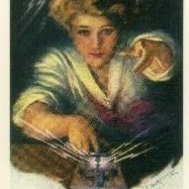Content Type
Profiles
Forums
Special Pages
Ham History
14652 Pledge
Store
Events
Gallery
Blogs
Downloads
Collections
Posts posted by NS7X
-
-
Thanks, Jim. The forum will be less of a talk and more of a round table discussion. I have no plans to record it. I'm just hopeful that I get about 20 warm bodies to attend. I anticipate those who attend will have a grand time, make a few friendships, and feel a little more confident about their skills.
-
 1
1
-
-
As a matter of full disclosure, I've been collecting opinions, ideas, and general thoughts about YL's as hams for an ARRL Rocky Mountain Division Convention forum entitled "A Ham in Her Own Right." I'll be holding the forum on August 12 in Albuquerque, NM. I am hopeful that this forum will serve to encourage YL's to become more active and more confident as ham radio operators.
Wish me luck.-
 1
1
-
-
I think your SOTA idea may have some merit. I also think we really need more YL instructors and VE's. So many women become licensed in order to placate their OM, and have little to no interest in ham radio. When they take a class, it's usually taught by a man who has little to no understanding of the rich legacy our licensed grandmothers left us, nor do they have a clue how women tend to process technical material. (For example, although I never took a ham radio class, I had difficulty with the novice and general class material because so much of it was, "Just trust us on this one because that's the way it is." When I got to the advanced/extra class material, I found it much easier because there was a lot more of "this is why it works" curriculum.) I think if more YL's taught classes, these women would have a much better feel for how they can "fit in" in the ham world. Trust me on this one, once they figure that out, there'll be no stopping them.
When I was first licensed in 1978, ham radio was well-populated mostly by old gray-haired geezers. Much of the "How to Save Ham Radio" discussions in those days consisted of how do we attract young hams. Well, 45 years later, I'm one of the old geezers, and we're still having the same discussion. I'm sorry your family has such a poor opinion of the fossil crowd. Over my decades as a ham, I have met some fascinating individuals - most of them men and many of them gray-haired - and I have formed some incredible friendships. Like you said, it isn't about pink vs blue. It's about CW vs SSB - Just sayin'.-
 1
1
-
-
Women have always been a significant minority in all things ham radio. But, historically, those women who joined the ranks of amateur radio operators in the olden days were impressive operators in their own right. For example, many were employed in the merchant marine service as the radio operator on board ocean going vessels in the days when a woman on board ship was a rarity.
From the early days, women have proven themselves to be gifted CW operators, and have earned their place of honor amongst the best of the best radio operators.
Today, after 100 plus years of radio history, and 50 or so years of "women's liberation," women are still relatively unusual among the ranks of ham radio operators. Yet, there are YL's doing extraordinary things and like their fore-grandmothers, they are rare. (Look up K2EZ on QRZ.com if you doubt me.)
So, the question yet remains, why is it so few women become YL's when they tend to just not only have the natural gift to operate a radio, but also have the innate talent to outshine their male counterparts?
-
 1
1
-
-
Thanks, Jim, for your kind words. I'm anxious to read your comments. As you pointed out, the answer to my query is rather complex.
When I first pondered it, I assumed the answers would be somewhat obvious. (I say answers because clearly there is more than one solution to this equation, as it were.) But the more I think about it, the more obscure explanations become. -
In the US, for every 20 hams only 3 are YL's. Why do you suppose that is?
-
 1
1
-
-
Back about the early 80's, I was a very active CW traffic handler. Depending on band conditions, I was quite comfortable receiving code at 35 - 40 wpm. But, being as how I had to keep a hard copy of all the messages I handled, and being as how I never learned how to type, my code speed was limited to how fast I could apply the pencil to the paper.
One night, after clearing bunches of messages, I was approached by a CFO operator for a QSO. I, of course, was thrilled because I knew CFO stood for the Chicken Fat Operators - the premier high speed CW ops group on the airwaves. These were the guys who enjoyed 75+ wpm QSO's.
Anyway, the CFO guy and I started off at about 45 wpm, and he gradually QRQ'd the code speed up to 55+ wpm (my estimate). Well, to make a long story short, after about three hours of passing CW traffic, and entering into a QRQ contact, my brain turned to mush. I guess you could say I flunked my Chicken Fat Operator test. Even so, I was thrilled to find I had at least been tested.
Some 40 years later, I'm delighted to learn that the CFO is still extant. And my understanding is that 65 -75 wpm is the threshold for CFO membership. I'm also told that the elite CFO op's enjoy QSO's at 100 wpm. I don't know if that's true or not. I do know that I can't copy code fast enough to tell. -
I used to believe that integrity was doing what is right when no one was looking. I now understand that integrity is doing what is right regardless of who may be watching, and in spite of the price you may pay for not choosing the easy path.
-
 1
1
-
-
Here in New Mexico, we have a 2 meter/70 centimeter rag chew net which is on a linked repeater system. It meets on weekdays from 1445z to 1645z (and oftentimes longer. A lot longer...) It's called Rusty's Raiders and has been extant since the 1960's.
So, how come has this net survived so many years? Well, let's see...
First, I've been told that hams in New Mexico tend to be very active. Personally, I think that's because we have a pretty "high-tech" population thanks to our scientific labs (Sandia and Los Alamos) and research labs tend to be fertile grounds for growing hams. Additionally, we have a fairly high volume of tourists which increases the repeater traffic. Also, we are very fortunate in that we are able to plant our repeater antennas a mile or so above their coverage area. (Mountains make great towers...)
But what makes Rusty's Raiders work? Well, for one thing, each day of the week has a different net control. Monday is Merle's day, Tuesday you'll find Connie running the net, and so forth. Each net control has their own NCS (net control station) personality, strengths, and foibles. One net control apparently went to the Gary Cooper NCS school ("Yep. Nope.") and another has diarrhea of the mouth. One net control has a huge interest in the technical aspects of amateur radio, and another is happy to discuss his medical issues. But, they all share one common trait - they love chatting with people who check in to the net.
There is no protocol on Rusty's Raiders. No "Alpha through Foxtrot" or "Today's question is..." It starts with a brief preamble ("Priority or emergency traffic, come now....Our linked repeaters have a time-out" and so forth. And then the net control says, "Anyone want to check into Rusty's Raiders?" So for the next two hours, or so, the rag is chewed.
Topics on Rusty's Raiders range from, "Just wanted to check in for the numbers" to discussions about current amateur radio news, to conversations about digital versus film photography, weather talk - lots of weather talk, topics about the history of New Mexico, anecdotal stories about POTA, what's going on in the world of astronomy, and (of course) reports of liver and kidney function from the geriatric set. Frankly, I think it's more fun to listen to Rusty's Raiders than it is to participate. (But that's just because I'm more comfortable with a key than I am a mic.)
Personally, I think the secret to the longevity of Rusty's Raiders net is that we don't just like each other, but we also love talking to each other. That's kind of what ham radio is all about, isn't it?-
 1
1
-
-
Hi, Tiffany---
It's nice to have you on board, and welcome to the group.
In answer to your first question, you might want to check out https://www.fcc.gov/wireless/bureau-divisions/mobility-division/amateur-radio-service for information. Amateur (ham) radio license tests are administered by hams who have completed special training as Volunteer Examiners (VE's). There is usually a small fee (about $15 -$20) charged by the VE's to cover the cost of the exam. In addition, the FCC charges a $35 fee for the license. Ham exams (and classes) are offered all over the country by various ham clubs and groups.
Your second question refers to staying in contact with family members. Hams can only communicate with other hams. So if your family members are also licensed, there's no problem. If they aren't licensed, they'll need to be with another ham who can operate the equipment (called a control operator) while your family member talks on the radio. Or, you can send Radiograms (just like telegrams, except there is no charge for a Radiogram). If your family lives under your roof, your best bet is a GMRS license because it licenses everyone in your household.
Getting news from around the world doesn't require a license. You just need an appropriate receiver and antenna. However, if you want to talk to people from all over the world, you'll need a ham license.
Question number three? I got my ham ticket when, as a young bride, my new husband and I moved from my home in New Mexico to Iowa, and I was desperate to keep in touch with my family members back home - two of which were hams. I soon discovered the delights, the excitement, the thrills and chills of chatting with other hams from all over the place. That was 45 years ago. Over the years, I've "met" some wonderful people (a few of which have become close friends), some fascinating folks, some very clever fellows, a few who rescued me from dire situations ("Help! I've run out of gas!"), and a few #######s. Want to know the great irony? I never did make contact with my two licensed family members...
Finally, how much will it cost? That depends. You can spend a LOT of money. On the other hand, you can also get by by spending very little. Thirty bucks will get you a handheld VHF/UHF radio which may suit your needs just fine. If you're wanting to talk around the world, you can pretty easily spend a couple thousand on a rig, antenna, power supply, coax, etc. Or, if you're lucky enough to live near a ham club with an HF station, you could spend $35 a year for membership to the club with access to that club's station.
So, Tiffany, hope my comments help. If I can be of assistance to you, let me know. I'm sure you have lots of questions and concerns. Trust me on this one, ham radio is definitely worth the effort because there is literally a whole, wonderful world to explore when you're a ham.
Just sayin'.
---MaryAnn Cornett, NS7X
-
After the "Chinese spy balloon" was dropped in the Atlantic Ocean, I started hearing about more "mysterious" flying objects wandering around in the US airspace. And I thought, "Surely, the powers-that-be can tell the difference between an amateur launched pico-balloon and a balloon which is a serious threat to the US of A because of its nefarious potential."
Apparently I'm not the only one who is wondering about such things.
https://aviationweek.com/defense-space/aircraft-propulsion/hobby-clubs-missing-balloon-feared-shot-down-usaf-
 1
1
-
-
You have some good friends. Take good care of them,
-
K3MRI wrote in August 2019, "I'll start it off with a mini mini beef of mine and that's toilets."
Sorry, but that comment made me laugh as it brought a great memory to mind.
The OM (Bob) and I used to work the Bataan Memorial Death March which is a marathon held annually in the desert at the White Sands Missile Range in southern New Mexico. (It honors our troops who were captured early in World War II and who were force marched on the infamous Bataan Death March.) The runners in this event not only have the desert to deal with, but also the elevation, as well as the high desert winds. In addition to that, many of the runners enter in the "heavy class" meaning they carry 40 pound packs for the run.
Anyway, Bob and I were the "comm unit" for the last water stop on the marathon. We always had three or four porta-potties at our location, and trust me on this one, those porta-potties did a whole lot of business.
One year, those desert winds I mentioned earlier were extraordinarily strong. So strong, in fact, that our porta-potties didn't just blow over, but they went on a tumbling ride down an arroyo. Bob and I, of course, reported the incident to net control. Net control asked us how many porta-potties were occupied when they went air-borne. We answered that we didn't know, and further, we weren't going to be the ones to find out. So, net control sent LEO to do the (pardon the expression) "head count."
Fortunately, no one was in any of the prodigal-potties, but to this day I shudder to think what the insides of those chemical toilets must have looked like.
-
 1
1
-
-
Make me drool some more, why-doncha‽‽‽
(Don't suppose you'd be willing to introduce me to your buddy...😉) -
Bon jour, Georges!
-
If truth be told, I would dearly love to purchase enough real estate to plant an antenna farm which would rival the old Rockwell Collins antennas in Cedar Rapids, IA. Oh, my gosh - they had a log periodic which was to die for and, in my opinion, should have been declared a National Art Treasure. And then there were the phased verticals, the low frequency wire antennas, the stacked VHF arrays, the discones... So, yeah. The bulk of my unlimited cash would go to antennas. And the land to grow them.
As far as inside the shack is concerned, I'm having loads of fun with my IC7300 but would be happy to complete my collection of TenTec radios. Other than that, more and more Begali keys are always welcome.
Okay, Jim. Now that you have me seriously drooling over what could be, I think I need to go buy a lottery ticket, and a hanky. Just sayin'.-
 1
1
-
-
-
Hi, Ed and welcome to HamCommunity!
73 DE NS7X (MaryAnn) -
His name was Jack Phillips and he sent the most famous radio message in history. Well, if not the most famous, it was at least among the most infamous. At the tender age of 25, he was the senior radio operator and had already amassed years of experience.The night his message became famous (April 15, 1912), Jack operated a 600 meter rig running 5 kW, although only about 500 W actually made it to the Twin T antenna array. His spark gap transmitter wasn’t all that efficient, you see.He operated using the call MGY, the callsign designation for the ship he served on. As an employee of the Marconi International Marine Communication Company, Jack Phillips was well versed in the Marconi radio procedures – including the usage of CQD (meaning – All Stations Distress). So when his ship, the Titanic, collided with an ice berg and began taking on water, Jack signaled to anyone who had a receiver CQD de MGY.Following the collision, Harold Bride (the junior wireless operator) reported to the radio room. As the ship was sinking, Harold suggested Jack use the newer internationally recognized distress call, <SOS>. Half joking, Harold added, “This may be your last chance to use it.”Although the Titanic was not the first ship to use the prosign <SOS>, it was the first (and last) to use both distress signals. Unlike Jack Phillips, Harold Bride was one of the survivors of the disaster.This is a link to a facsimile of what the CQD/<SOS> call from the Titanic probably sounded like:By the way, as an historical side note, the ham radio operators on the eastern US seaboard spontaneously stayed off the air the night the Titanic sunk. They, instead, copied the rescue traffic as it happened in the North Atlantic. The next morning, thanks to the hams copying the names of the survivors as they were transmitted throughout the night, the newspapers were able to publish a survivors list.
-
The thing I think that is truly cool about the A-1 Operators Club is that you can't just fill out some paperwork and send it in to qualify. You have to be nominated by two A-1 Ops. Of all the wall-paper I've gathered over the years, I am most proud of my A-1 Op membership.
Another A-1 Op and I are about to surprise a local ham with his membership at a ham lunch next week, and we wanted to say a few words about the history of the Club. But I haven't been able to find much more info than the date of organization, and the guy who announced its formation. Apparently, A-1 Operators tend to lack braggadocio - an endearing characteristic, but one which frustrates historians.
On the bright side, my ham friend and I, when we make the presentation, won't have a chance to bore anybody because our "few words" will be just that - a few words.
You said, "I like the idea of ‘knowledgeable’ operators – not for the purpose of feeling good about one’s own achievements or capacity but rather for the purpose of sharing knowledge and inspiring others to improve and achieve." That pretty much sums up what an A-1 Op is all about. I think that today's hams inherited a great tradition left to us by those who invented the ham culture. It is my hope that our legacy will be that we pass that foundation on to those that come after. -
Hi, James! Welcome to Ham Community! It's good to have you!
73, de MaryAnn, NS7X
-
Hi, Jim. Welcome to Ham Community!
73 de MaryAnn, NS7X
-
Congratulations, Jay, on getting your ticket! And welcome to Ham Community! Now that you have your license, you have a whole world to explore. Enjoy the journey!
73 de MaryAnn, NS7X
-
(Please note: The following was written by a YL who has firmly planted her tongue in her cheek.)
Point out to your XYL that a tower next to your house increases the property value. If you ever decide to sell, a prospective buyer who is a ham will be anxious to buy.
Remind her that having an impressive display of antennas will discourage a burglar, a home invader, or a criminal type person from making you the target of a crime because, after all, your house looks like an official, important person type house with immediate access to law enforcement and bad guys really won't want to mess with you.
Or, you could explain to her that some radio frequencies are resonant with various insect exoskeletons, and every time you transmit on your favorite band, you are sending cockroaches, termites, or whatever bug-a-boos which frequent your QTH to your neighbors where they will become your neighbors' problem.
Reassure her that, because you have a fantastic antenna system, she will always know where you are. You won't be carousing, playing poker with the boys, or spending time at the bar. You'll be in the shack, working the world.
As a last resort, encourage her, bribe her, or beg her to get her ham license. Of course, if you go this route, you'll no doubt have to buy more radios. What a shame...
-
 1
1
-
10 newly posted or edited posts
-
Christmas on the Rhine Boat Trip Started
-
Last Minute Items Started
-
Volunteer Update Emails Started
-
Flashlights left at MCM Check-In Started
Quick Menu
- Ham Community - Homepage
- Ham Boutique - Get your farkle
- Ham Census - Shape the future of Ham Radio
- Ham Weblinks - Curated links
- Ask the Elmers - Direct access
- Ham Quizzes - Keeping you sharp
- Ham Tutorials - Learn from the best
- Ham Speakers - Give a talk, find a speaker
- Ham Volunteers - Organize and volunteer
- Support - For site or boutique problems












A Ham in Her Own Right
in Ham topics in general
Posted
Follow up on the "Ham in Her Own Right" forum at the Mountain Division ARRL Convention held in Albuquerque last August (gosh, has it already been that long ago?)
Although the turn-out was small, I think the results were huge. I've noticed that several of the YL's who attended have had a higher on-air profile than they had previously. I've noticed that locally, YL's are now using "33" with each other instead of the "73" standard. And I know of at least one YL who has become a VE, - YES!
Here are my conclusions:
First, YL's who are left to their own devices tend to become fantastic operators. The ones who don't succeed are often the ones that have a "helpful" OM hovering over their shoulder commenting on every thing the YL does on the air. These YL's learn to be fearful that anything they do on the air may invite an unwanted and unsolicited "correction."
Second, K3MRI is right. The way to a YL's heart is through POTA. There's lots and lots of YL activity on POTA, and the ladies are having one heck of a good time.
Third, we need more YL instructors and VE's. As much as I love and respect the OM's in my life, if truth be told, YL's see things a little bit differently and having a YL instructor and/or VE can make a big difference to a newly licensed YL.
Finally, I strongly believe that YL's who receive a little encouragement, who have someone they can ask an occasional question of, and who enjoy a fellow ham who respects their abiiity will be "A Ham in Her Own Right."